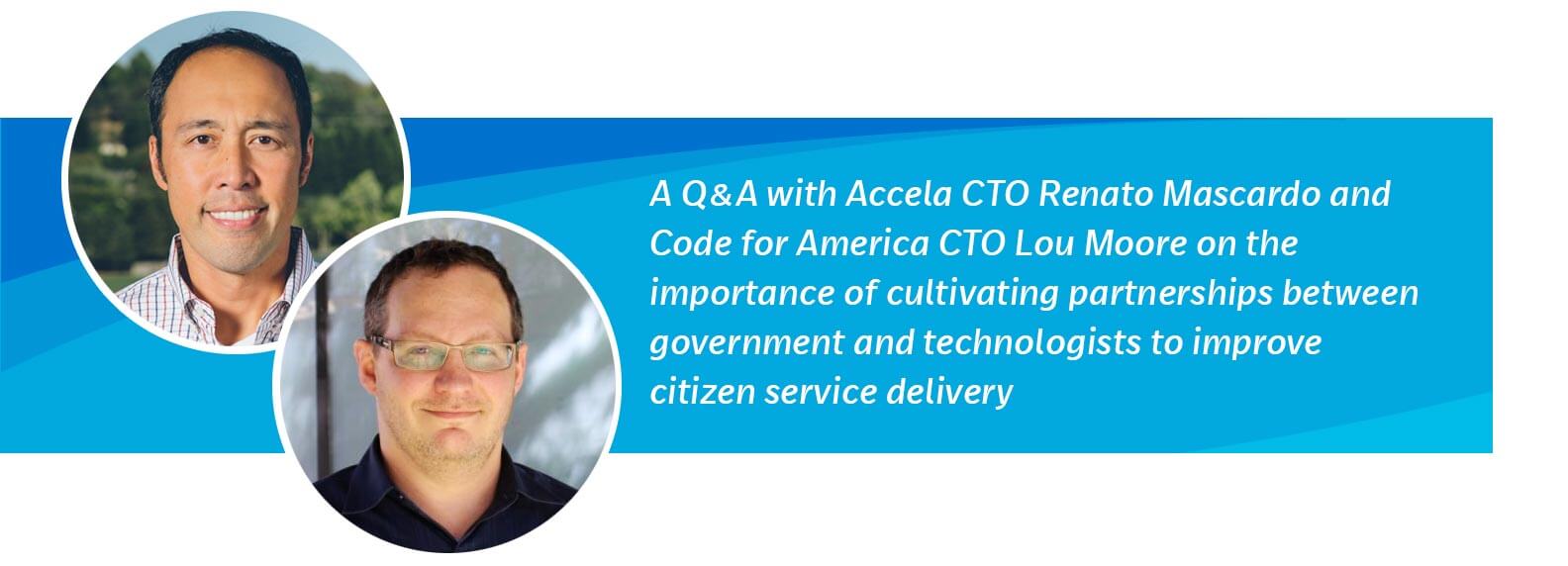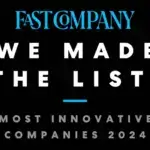
This piece is cross-posted from the Code for America blog. A Q&A with Accela CTO Renato Mascardo and Code for America CTO Lou Moore on the importance of cultivating partnerships between government and technologists to improve citizen service delivery
Every government organization knows that digital transformation is inevitable. But what does it look like, and how can it be achieved successfully and efficiently? As government digitization evolves, it is critical for agencies and technologists to work together to leverage open data as they continue to tackle some of today’s biggest challenges and enhance the modern relationship between citizens and government.
Renato Mascardo is responsible for managing the Accela’s engineering, cloud and IT operations, and has more than 20 years of experience leading technology organizations, coupled with extensive expertise taking enterprise, consumer and government products to market. His past proven successes in leading iconic Silicon Valley technology companies include managing teams for Rosetta Stone, Atari, Digital Globe, Hewlett-Packard and others.
Lou Moore is Code for America’s interim co-CEO and CTO. He began building high-performance technical teams and effective consumer products at scale while serving as Director of Product Engineering at social networking destination hi5, and he most recently served as VP of Software at Jawbone, where he led software development from applications to infrastructure.
In an interview with Accela, Mascardo and Moore provide insight into today’s digital ecosystem and how technology partners can build partnerships with agencies to foster connected communities through shared data.
What are the biggest challenges for government CIOs and CTOs, specifically when undertaking a digital transformation?
Renato: The pressure on government CTOs and CIOs is enormous—to re-architect entire systems quickly, cost-effectively and without breaking anything. There’s no choice but to undertake a digital transformation, even if it can be scary and costly. I think the biggest challenge for government CIOs and CTOs is the mind shift that must take place. Digital transformation requires a whole new way of thinking. In fact, I like to say that moving to the cloud isn’t a transaction, it’s a relationship. And this new relationship is based on a new kind of trust—one that’s built upon the brilliant basics (stability, availability, reliability, quality, security) and connected through open APIs and shared data.
Lou: Government technical leaders carry tremendously complex systems on their shoulders and hold a lot of risk. One of the biggest challenges we find that we can help with is finding low-risk ways to try new approaches, get small wins, and get moving down a path to digital transformation that is centered around better service outcomes. We all know that “big bang” transformation projects are less likely to succeed than a user-centered, iterative, data-driven and goal-focused approach, but the system CIOs/CTOs are operating in doesn’t always make it easy to do the right thing.
What do you think is the single most overlooked element of making the transition towards digital services?
Lou: I’d say the single most overlooked element is a deep understanding of client needs. There are massive technical challenges in digital transformation as well to be sure, but if you aren’t building the right thing then there’s no technology choice that’s going to save you. That means there needs to be an investment in user research, service design, and product management capabilities and a move towards outcome-focused multidisciplinary teams alongside investments in new and improved technology.
Renato: I would say it’s the fact that digital transformation is inevitable and it’s coming FAST. Every government organization has set out on the journey, but it hasn’t been a smooth one for most. Some government leaders embark on a journey to the cloud and believe they can just back into it, but there are major changes that will need to occur. The entire ecosystem is changing and they may not know it if folks are looking at it from a data center perspective. You aren’t just changing your systems, you’re changing the way you think, the way you manage and verify services, the way everyone does their jobs. This is where aligning with the right partners comes in, one who can bring years of expertise to the table on day one, and share best practices from others who might be farther along on their transformation journey.
What are some of the biggest benefits for government agencies in moving to digital services?
Renato: Local governments are the last mile, the first responders, the people that keep citizens safe and thriving. To ensure safe, resilient services, they MUST move to the cloud. But digital transformation is not a lift and shift change. There are enormous benefits to moving to the cloud. Most obviously, they will be able to outsource uptime/availability, security and mobility. They will hire differently and they will finally have the flexibility to shift their energy and attention to proactively redefine citizen engagement, away from maintaining servers, networks and VMs.
Lou: We believe that government services can be simple, accessible, and easy to use; that outcomes can be measurably better; that better can cost less; and that we can serve everyone with respect and dignity. Now, there’s no technology that just does all of that out of the box, but when teams move to the cloud, orient themselves around outcomes, and focus on continuous delivery to enable frequent shipping, it unlocks some pretty magical things. Suddenly you have a platform for learning how people use your services and the ability to evolve them to better meet their needs. You can set up tight feedback loops, gaining better situational awareness and an ability to actually tell what drives outcomes. You can try new ideas, starting small, and quickly scale them up to help more people when they work. Digital delivery can also help meet people where they are, on their own time. Taken together, there’s just a huge opportunity to provide a better client experience. And it can cost less too!
How can technologists be good partners in helping agencies in their digital transformation process?
Lou: Trust and empathy are absolutely key. One of our operating principles is to “work with, not for the people we serve,” and that applies to public servants as much as it does to clients. So, just as we center client needs in our work, we and other technology partners also need to respect, support, and understand the experience of public servants from leadership to front line workers. Similarly, just as we focus on identifying and removing barriers that clients face in obtaining services, we and other technology partners need to focus on identifying and removing the barriers that public servants face as they strive to do the right thing for their clients and deliver on their vision for better public services.
Renato: The answer to your question is actually a critical word in the question itself. It’s a process and it is very important to keep that in perspective. Forming a partnership with a trusted technologist is key, and one who has been there before and can help guide agencies through the journey. Agencies need to be able to lean on their expertise in everything from cloud security to thought leadership and to feel their technology partner understand and empathizes with every step.
What does “connected government” mean to you?
Lou: I think of a connected government as one that centers the needs of clients and is oriented around continuously evolving as those needs evolve. It’s a responsive government. A government that meets people where they are and when they need it. A government that is open, collaborative, outcome-focused, data-driven, and able to not only meaningfully improve peoples’ lives but to also be improved by the people it serves.
Renato: “Connected government’ is all about how technology partners can build relationships with agencies to foster the trust needed to build connected communities through shared data. The collaborative utilization of data across federal, state, and local governments can open up possibilities to radically improve digital services, increase citizen participation, make governments more accountable, and better inform decisions.
What do you hope to see from local and state agency IT leaders and their technology partners in 2020 and beyond?
Renato: It’s a critical time for local leaders across the country. Now, more than ever, government agencies are feeling the pressure to deliver the “Amazon experience” of easy, fast, convenient, and transparent delivery of quality service, and with an eye on budget constraints. To keep pace, agencies are increasingly looking to cloud technology and partnerships to save valuable time and resources and meet increasing citizen expectations. My hope is that moving forward, government CTOs and CIOs and their technology partners can have a valuable exchange of ideas around the concept of connected government to leverage in their digital transformation journey.
Lou: I also hope and believe that government leaders and technology partners can share their sometimes different perspectives on digital transformation and work together to craft innovative solutions. It’s a huge topic, the systems we’re working on are complex, and there aren’t easy or right answers. But we have the chance to collaborate and share ideas with people from all across the ecosystem who are doing this challenging, generational work together.
To learn more about how agencies and technology partners can work together to tackle the next frontier of digitization, check out Accela’s recent blog post, ”Moving to the Cloud is a Relationship, Not a Transaction.”


